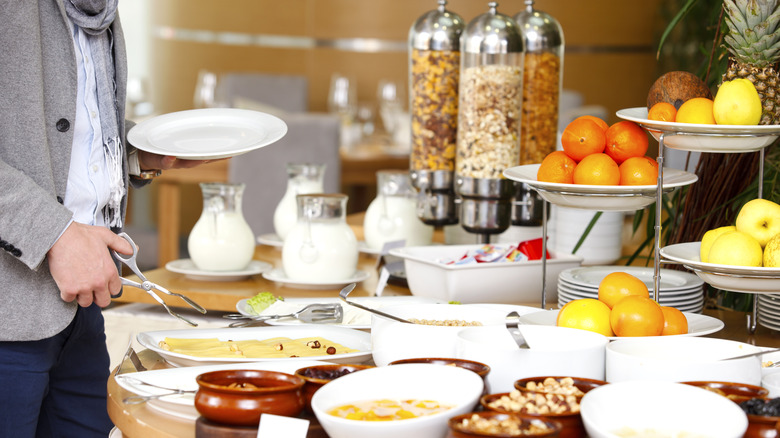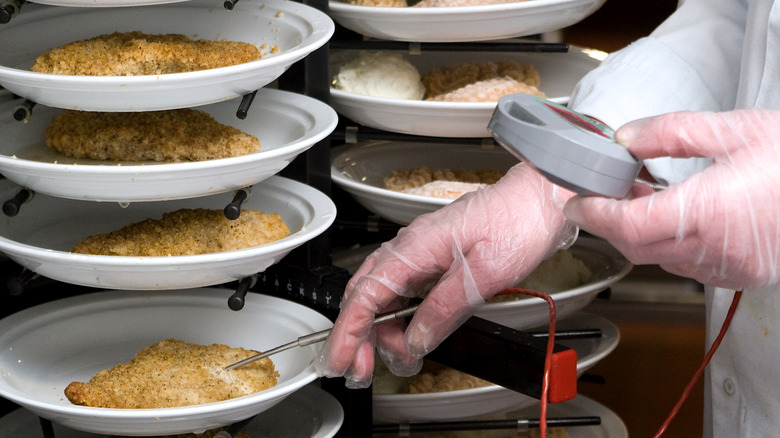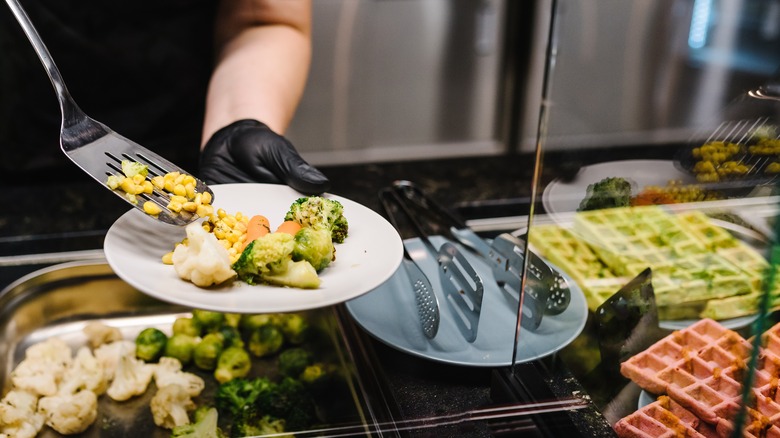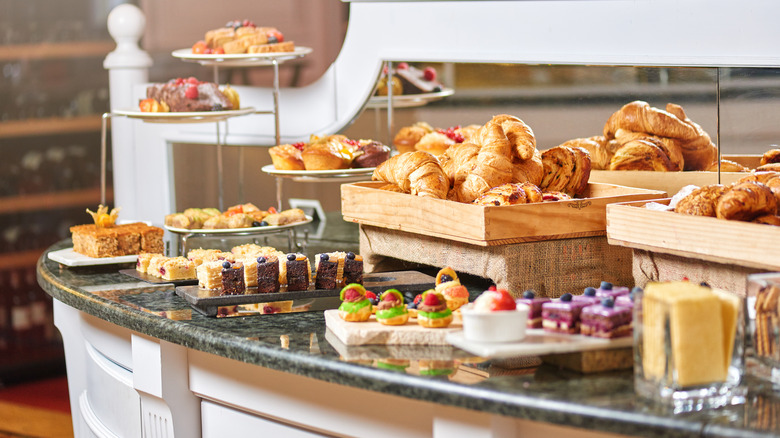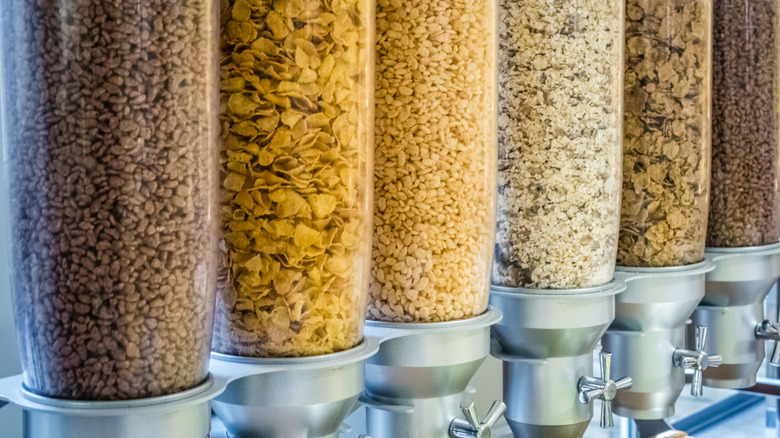10 Red Flags To Watch Out For When Eating At A Breakfast Buffet
Few things can be compared with the feeling of walking into a breakfast buffet. The aroma of freshly baked bread, pastries, and brewed coffee, the array of colors and textures from the vibrant fruit displays to the steaming trays of hot food — and the seemingly endless food choices that go from a classic cereal bowl to an elaborate and tasty omelet. It's as if you've been transported to another world where you are surrounded by an abundance of food and a galaxy of flavors. However, while breakfast buffets can be compelling to the untrained eye, there are also some red flags you should take into account before getting a little bit of everything on your plate.
Buffets, in general, are a great option if you're looking for a cost-effective meal or have dietary restrictions or preferences, because you can choose the items that suit your needs. Nevertheless, with so many people handling utensils and serving dishes, it can be easy for germs and bacteria to spread from person to person. Moreover, if foods are not handled properly, buffets can be a breeding ground for disease-causing bacteria, viruses, and parasites (also known as foodborne pathogens) that lead to foodborne diseases. According to the Centers for Disease Control and Prevention (CDC), as of 2018, foodborne illnesses were reported as the cause of sickness of 48 million Americans, of which it is estimated that 128,000 ended up in hospital care and 3,000 resulted in death.
With that in mind, it's important to be aware of the potential health concerns of eating at a buffet. Here are 10 red flags to watch out for to ensure you enjoy the variety and convenience of a breakfast buffet while minimizing the risks.
Foods are displayed at the wrong temperature
Have you ever gotten to a buffet's food trays only to discover that the breakfast sausages are warm rather than hot and the deli meats are at room temperature instead of cold? If so, don't walk; run in the opposite direction because this is one of the fastest ways to get food poisoning. When it comes to handling food — which involves every step of the food production chain, such as preparing, cooking, storing, and serving food in a safe and hygienic way — doing so in the correct manner can make a difference between providing a safe and delicious meal or promoting the growth of hazardous microorganisms that cause foodborne diseases (aka food poisoning), according to the Centers for Disease Control and Prevention (CDC).
While food can get contaminated way before it reaches a restaurant's kitchen, the CDC explains that mishandling it can increase your chances of getting sick. One key point to prevent this is by monitoring the temperature of your food, seeing that disease-causing germs thrive in food left at room temperature or between 40 degrees Fahrenheit and 140 degrees Fahrenheit, also known as the "Danger Zone." Therefore, the CDC states that hot food items should be served at 140 degrees Fahrenheit or higher, and cold food items should be served at 40 degrees Fahrenheit or lower — restaurants achieve this by using chafing dishes, warming trays, or placing dishes over trays filled with ice. If you notice that the food is not at the correct temperature, it may have been sitting out for too long and could be unsafe to eat.
Food trays are refilled rather than swapped
Picture this: You're headed toward your favorite breakfast dish, and you notice there's only one item left. Luckily, the server is on the way to save your morning with a brand new batch of food straight from the kitchen, only to pour it on top of the last batch's leftover food. If this ever happens to you, try looking for something else to eat because one big red flag to watch out for is the way that the servers handle old and new batches of food, and this scenario is a major no-no.
According to the Food and Drug Administration (FDA), it is crucial for buffets to swap food trays instead of refilling them with new food to help prevent the spread of foodborne illness and ensure food safety — there are a couple reasons to back this up. First, you don't know how long an old batch of food has been sitting on the buffet and the chances of harmful microorganisms growing on food increase after two hours of being at room temperature. And second, germs from other people's hands can also contaminate the food. Thus, when food trays are refilled with new food, there is a risk of contamination between the fresh food and any remaining food on the tray. In contrast, by swapping out food trays with fresh ones, buffets can help reduce this risk and ensure that the food served is fresh, safe, and high-quality.
Raw and cooked foods are displayed next to each other
You might think that having deli meats, cheese, and cured salmon served right next to the quiche, pancakes, and hashbrowns is a time-saving technique for displaying food at a buffet. After all, it makes it easier for you to get everything you need at one place instead of walking from one side of the buffet to the other looking for your breakfast staples. However, this can't be farther from the truth, seeing that buffets should have separate sections for hot and cold items instead of displaying them next to one another for several reasons related to food safety and quality.
On the one hand, having separate sections for hot and cold items helps to prevent contamination between the different types of food. As the Food and Drug Administration (FDA) explains, cold and raw foods should be kept at a temperature of 40 degrees Fahrenheit or below, and hot food should be kept at a temperature of 140 degrees Fahrenheit or above to prevent the growth of bacteria. By keeping these items separate, there is less risk of cold items warming up or hot items cooling down to unsafe temperatures. And on the other hand, separating hot and cold items can help maintain the quality and freshness of the food (via Oregon State University).
Fried, scrambled, and hard-boiled eggs are undercooked or runny
Some people can't start their days without a cup of coffee, and others can't go about their days without an egg-containing breakfast. If you belong to the latter, you may want to think twice before getting your daily serving of eggs at a breakfast buffet — particularly if your only choices are undercooked or runny eggs or egg dishes, seeing that they can pose a serious health risk. According to the Food and Drug Administration (FDA), eggs are a common source of foodborne disease, and consuming undercooked or raw eggs can increase the risk of contracting illnesses such as Salmonella.
Salmonella is a bacteria that causes food poisoning when food isn't handled correctly. It is commonly present in eggs (even fresh and clean-looking ones), and it can lead to symptoms such as diarrhea, vomiting, fever, and stomach ache, which may be mild and resolve at home or severe and require a trip to the hospital. Luckily, you can prevent the risk of foodborne illness from undercooked eggs by ensuring that eggs are cooked to the correct temperature. The FDA recommends cooking eggs thoroughly to avoid runny yolks or egg whites. Also, the internal temperature should reach at least 160 degrees Fahrenheit — while you may not know at which temperature the eggs were cooked, firm egg whites and yolks are a good indicator of proper egg handling.
Lastly, buffets should also make sure that eggs are not left out at room temperature for an extended period of time, as this can increase the risk of bacterial growth. If possible, try to get your eggs from an omelet bar (even if you're only looking for scrambled eggs) to ensure you're eating freshly cooked eggs instead of ones that may have been sitting there for a while.
There are no sneeze guards
Sneeze guards are a crucial component of any buffet setup, and their absence can increase the risk of contamination and the spread of illness. This is because sneeze guards work as food shields that provide a protective barrier between the food and the diners, especially in crowded or self-serve settings like buffets, where multiple people may be serving themselves from the same food trays and may accidentally sneeze or cough on the food, touch it with their hands or personal utensils, or even talk directly over the food, increasing the risk of contamination (via Safely6ft).
In addition, sneeze guards help prevent the spread of airborne particles, such as respiratory droplets, which can carry viruses and other germs. This is particularly important in the era of COVID-19, where the risk of airborne transmission is a major concern. Moreover, aside from protecting the food, sneeze guards also serve as a visual reminder to diners to practice good hygiene, such as covering their mouths and noses when coughing or sneezing — this helps promote safe and hygienic practices, further reducing the risk of illness. Without sneeze guards, buffet foods are left exposed to the environment and to any germs or bacteria that may be present. And so, if you walk into a breakfast buffet and don't see any around, rest assured this is a major red flag.
Pre-cut fruit is the only fruit option
Pre-cut fruit can be a healthy addition to any breakfast and a convenient option at a breakfast buffet. Still, it also poses some risks if it has been sitting out for an extended period of time, and unless you've watched it leave the kitchen, there's no way to know how long that bright-colored fruit display has been out there waiting for someone to try it. You may be wondering how something as healthy as pre-cut fruit can be considered a red flag at a buffet – it has everything to do with its processing, according to the Food and Drug Administration (FDA).
Per the FDA, when fruit is cut, the protective skin (which acts as a natural barrier) is breached, exposing the flesh to the environment and any bacteria that may be present. Once this happens, there are two main reasons that increase the risk of contamination. One is because the fruit's water content and nutrients are now available to microorganisms after being cut. The other is due to the absence of a heating process that would help get rid of any disease-causing germs. Therefore, pre-cut fruit is more susceptible to contamination and spoilage. Nevertheless, buffets can follow some basic food safety guidelines to reduce the risk of illness from pre-cut fruit. Cold foods such as fresh fruit should be kept under refrigeration until serving, which should be done on top of ice to keep them from warming up (via the FDA). Alternatively, if you don't want to take any chances, you can go for whole fruits like apples, bananas, pears, or peaches.
There are not enough serving utensils
While having seemingly endless choices of food available may be the first thing that comes to mind when you think of a breakfast buffet, there is another (possibly) more important detail that often goes unnoticed until it's too late: Do you have the proper tools to get that food safely onto your plate? Before committing to a buffet, look around to check whether it has enough serving utensils for every item on display, as a lack of utensils may reflect a lack of safe and hygienic practices — and yes, that's one big red flag!
When there aren't enough utensils, people may resort to either using their hands or the same utensils for different items, which significantly increases the risk of cross-contamination and the spread of germs that result in food poisoning. Cross-contamination is a term that describes the transfer of harmful microorganisms or allergens from one food item to another. In a buffet setting, it can easily happen through contaminated utensils or by touching food with unwashed hands. For example, a spoon used for serving scrambled eggs may inadvertently be used to serve bacon, and since eggs are one of the nine major food allergens, it can contaminate the bacon, which a person with an egg allergy may consume, thinking it is a safe option.
Bread and pastries are not covered
As the Canadian Institute of Food Safety explains in its list of rules for buffet food safety, buffets should cover all items when possible. However, you might have noticed that hot items are often the only ones that get their own lid, and it is mainly to keep their temperature from dropping into the "Danger Zone" and prevent the growth of harmful bacteria. Yet, what about those (hopefully) freshly baked breads and pastries? Just as their sweet smell draws you in, it may also captivate unwanted guests, such as insects and flies, which carry a range of harmful bacteria and diseases that can be transmitted to the food and cause illness in those who consume it (per Food Inspector).
Additionally, when bread and pastries are left uncovered, they are exposed to the surrounding environment and are more likely to become contaminated by any germs present in the air or other pollutants, including bacteria from coughs or sneezes, contaminated surfaces, or people's hands. Finally, leaving bread and pastries uncovered can also cause them to dry out and become stale or unappetizing, which, aside from leading to food waste, is certainly something you would not want to start your day with.
The place is understaffed
Buffets are known for being a self-serve kind of deal. Yet, despite what you might think, having enough staff is essential for ensuring the safety and quality of the food being served. Since buffets rely on people getting their own food, the Canadian Institute of Food Safety explains that one of the major risks of contamination at a buffet is actually the customers — because they may not know the correct food handling practices. However, when there is enough staff around, they can supervise any potential contamination accidents and take charge of the situation to ensure the safety of others.
In addition, another risk of an understaffed buffet is the potential for food to sit out at unsafe temperatures for extended periods of time, which can happen when there is no one to check and replenish the food or monitor its temperature regularly. Lastly, not having enough staff can also lead to poor sanitation practices, such as dirty plates and utensils not being cleared in a timely manner, which can create an unsanitary environment and lead to a lower-quality breakfast experience. Therefore, look around to see whether enough staff members are present to ensure the food is properly presented and monitored, and walk the other way if there aren't.
The cereal bar has open containers
Just as some people like to start their days with a serving of eggs, others rely on a good ol' bowl of cereal. Yet, there's nothing more disheartening than reaching the cereal bar at a breakfast buffet only to find that they're displayed in open containers instead of cereal dispensers. Having cereal sit in open containers can easily increase the risk of contamination by being exposed to airborne contaminants. Plus, when multiple people are accessing the same container, it increases the chances that someone may inadvertently contaminate the contents with their hands or utensils. Also, let's not forget that when you leave your cereal exposed to fresh air, it becomes stale or goes bad after a period of time (via Rosseto).
Open cereal containers are a red flag because they can pose a number of risks and concerns at a buffet, including contamination and food waste. To mitigate these risks, buffets should consider alternative methods, such as cereal dispensers or covered containers, which promote good hygiene practices and ensure the cereal is fresh and safe for consumption.
